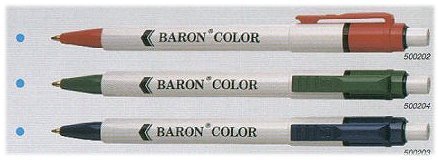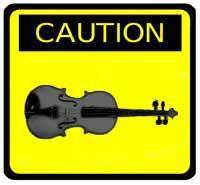Marc Abrahams's Blog, page 560
July 21, 2012
Non-Newtonian sink flow cusps self-quibble
“Instead of in general in particular it should say in particular. Instead of sharp cusps it should say non-axisymmetryc cusps.”
So say authors of the study
Non-Newtonian sink flow cusps
Authors: Diego Samano, Roberto Zenit
arXiv:0910.3269
BONUS QUESTION: Did they commit a spelling error with the word “axisymmetryc”?

High-Specificity Study of the Month: Espresso/bariatric/etc
This month’s High-Specificity Study of the Month is:
“Regular coffee but not Espresso drinking is protective against fibrosis in a cohort mainly composed of morbidly obese European women with NAFLD undergoing bariatric surgery,” Rodolphe Anty, Sophie Marjoux, Antonio Iannelli, Stéphanie Patouraux, Anne-Sophie Schneck, Stéphanie Bonnafous, Camille Gire, Anca Amzolini, Imed Ben-Amor, Marie-Christine Saint-Paul, Eugenia Mariné-Barjoan, Alexandre Pariente, Jean Gugenheim, Philippe Gual, Albert Tran, Journal of Hepatology, epub July 20, 2012.
(Thanks to investigator Ivan Oransky for bringing this to our attention)
BONUS (unrelated): There are many Albert Trans in this world. One Albert Tran is a co-author of the study. Another, equally spirited Albert Tran is featured in the video below. The video is called “Lollipop routine by Albert Tran”:

Your eyes look like sunflowers (or: careful with copper)
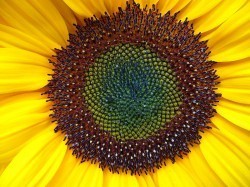
Sunflower – image from Wikimedia Commons
Chromium, copper, iron, manganese, molybdenum, selenium and zinc sound like the components of a sophisticated machine – indeed there are, when you consider that the human body is a machine. Below is an account of how one of these components can make parts of a person resemble a sunflower:
Copper in small quantities is essential for health. Too much or too little copper is not good for health.
In Wilson’s disease [Hassan A, Masood F. Wilson's Disease: a review. J Pak Med Assoc, 2004 54(9):479-84.] in which too much copper accumulates in the body, the eyes of affected people can look like sunflowers.
Here is more on this condition known as sunflower cataracts.
BONUS: Wilson’s disease belongs to a group of diseases called inborn errors of metabolism

July 20, 2012
Best Ballpoint Pens for Bystander Cricothyrotomy?
If you want to be prepared to operate on someone’s cricothyroid membrane in an emergency, consider always carrying a pen — but perhaps not just any pen. Consider this:
“Airflow Efficacy of Ballpoint Pen Tubes: A Consideration for Use in Bystander Cricothyrotomy,” Owens D, Greenwood B, Galley A, Tomkinson A, Woolley S., Emergency Medical Journal, 2010 Apr;27(4):317-20. The authors, at Princess of Wales Hospital, Bridgend, Wales report:
OBJECTIVE: To examine the suitability of commonly available ballpoint pens as a substitute emergency tracheostomy tube.
METHODS: Commonly available ballpoint pens were examined and compared against two standard cricothyroidotomy sets. The pens were evaluated for dimensions, speed of construction of a temporary tracheostomy tube and airway resistance with differing flow rates.
RESULTS: Internal diameters of the pens varied considerably. Time taken to construct a temporary tube ranged from 3 to 170 s, and in the majority of pens the airway resistance increased dramatically as the airflow rate increased.
CONCLUSION: Contrary to popular belief, the majority of ballpoint pens appear unsuitable for use as a substitute tracheostomy tube. In this study only two pens fulfilled the criteria for use: the Baron retractable ballpoint and the BIC soft feel Jumbo.
(Thanks to investigator Johnty Wang for bringing this to our attention.)
BONUS: Write Ho! The Long-Lost, Ingested Pen Turns Up

Smile collection in Amsterdam
A research team at The University of Amsterdam and at NEMO in Amsterdam is collecting smiles — or at least moving images of smiles. Their database currently has about 400 smiles. They present this official description:
UvA-NEMO Smile Database is a large-scale smile database which has 1240 smile videos (597 spontaneous and 643 posed) from 400 subjects. Ages of subjects vary from 8 to 76 years. Videos are in RGB color and recorded with a resolution of 1920×1080 pixels at a rate of 50 frames per second under controlled illumination conditions. For further illumination and color normalization, a color chart is present on the background of the videos.

The data have contributed to at least one study:
“Are You Really Smiling at Me? Spontaneous versus Posed Enjoyment Smiles,” H. Dibeklioglu, A.A. Salah, Th. Gevers, Proc. European Conference on Computer Vision (ECCV), Firenze, 2012.
(Thanks to investigator Diana Issidorides for bringing this to our attention.)

July 19, 2012
Sensory attributes of haddock balls in the cold
Haddock balls suffer from the cold, according to this Icelandic study:
“SENSORY ATTRIBUTES OF HADDOCK BALLS AFFECTED BY ADDED FISH PROTEIN ISOLATE AND FROZEN STORAGE,” Gholam Reza Shaviklo [pictured here], Sigurjon Arason, Gudjon Thorkelsson, Kolbrun Sveinsdottir and Emilia Martinsdottir, Journal of Sensory Studies, vol. 25 (2010) 316–331. (Thanks to investigators Philip Rubin and Robert Remez for bringing this to our attention.) The authors, at the University of Iceland, report on their experiment:
“The results showed that both groups of haddock balls containing isolate and control sample had no deformation during the setting of fish balls.”

Left v. Right: How Academics Face-Pose on the Web
A new study, the purpose of which some may find delightfully puzzling, looks at the self-portraits scholars put on their home pages:
“How Academics Face the World: A Study of 5829 Homepage Pictures,” [pictured here], Rebecca Callahan, Dana Michalski, Nicola Brewer, Emma Turner, , Nicole Annette Thomas, Mike Elmo, Richard Nicholls, PLoS ONE, 7(7), 2012, e38940. The authors, at the University of South Australia and at Flinders University, report:
“It is now standard practice, at Universities around the world, for academics to place pictures of themselves on a personal profile page maintained as part of their University’s web-site. Here we investigated what these pictures reveal about the way academics see themselves.
Since there is an asymmetry in the degree to which emotional information is conveyed by the face, with the left side being more expressive than the right, we hypothesised that academics in the sciences would seek to pose as non-emotional rationalists and put their right cheek forward, while academics in the arts would express their emotionality and pose with the left cheek forward. We sourced 5829 pictures of academics from their University websites and found that, consistent with the hypotheses, there was a significant difference in the direction of face posing between science academics and English academics with English academics showing a more leftward orientation. Academics in the Fine Arts and Performing Arts however, did not show the expected left cheek forward bias.
We also analysed profile pictures of psychology academics and found a greater bias toward presenting the left check compared to science academics which makes psychologists appear more like arts academics than scientists.”
BONUS QUESTION (slightly philosophical, in a non-academic sense): Is there a relationship between face-posing and face-palming?

July 18, 2012
Write Ho! The Long-Lost, Ingested Pen Turns Up
Medicine and literary production combine in a fairly unusual way in this study:
“An incidental finding of a gastric foreign body 25 years after ingestion,” Oliver Richard Waters, Tawfique Daneshmend, Tarek Shirazi, BMJ Case Reports, 2011. The authors, at Royal Devon & Exeter Hospital Foundation Trust, Exeter, UK, report:
A 76-year-old female, with a blameless medical history other than well-controlled depression, was referred for urgent investigation due to weight loss and diarrhoea. A flexible sigmoidoscopy demonstrated severe diverticulosis and a subsequent CT abdomen showed a linear foreign body in the stomach but no other abnormality (figure 1). Her symptoms resolved spontaneously. On subsequent questioning, she recalled unintentionally swallowing a pen 25 years earlier. While she was interrogating a spot on her tonsil with the pen she slipped, fell and swallowed the pen by mistake. Her husband and general practitioner dismissed her story and plain abdominal films done at the time were reported as normal. A gastroscopy demonstrated a plastic felt-tip pen sitting in the lumen of the stomach without evidence of any gastric damage…. It was subsequently removed in a combined endoscopic and ear, nose and throat procedure under general anaesthetic. The pen was still in working order (figure 2).
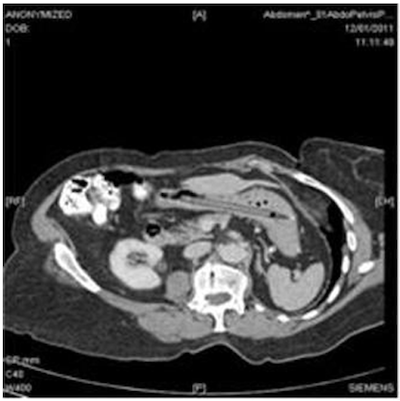
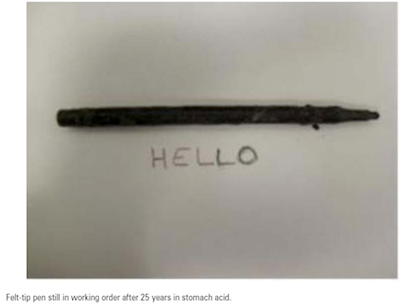

Babbling about science and improbable things, in io9
Robert Gonzalez interviewed me, for io9 and Gizmodo, about science and technology, and the Ig Nobel Prizes, and how people (especially me) get interested in such things.

July 17, 2012
Instrumental Maladies (part 4: Violins)
A final (but by no means complete) roundup of the work-related instrument-specific health-risks that professional musicians may encounter during their career …
Part 4 : Violins
• Violin chin rest eczema due to east-indian rosewood (Dalbergia latifolia ROXB).
• Chin rest allergy in a violinist
• Allergic contact dermatitis on a violinist’s neck from para-phenylenediamine in a chin rest stain
• Fiddler’s fingers’: violin-string dermatitis
• Development of Garrod’s pads in the fingers of a professional violinist
• Jaw dysfunction in viola and violin players.
• Transient entrapment neuropathy of the posterior interosseous nerve in violin players.
• Bruxism Related to Violin Playing
Musical Note : As Improbable readers will probably be aware, this Instrumental Malady turned out to be a hoax.
[This concludes Improbable's partial list of Instrumental Maladies.]

Marc Abrahams's Blog
- Marc Abrahams's profile
- 14 followers








